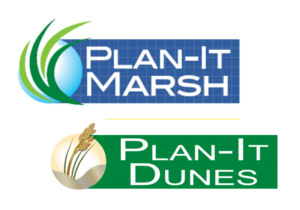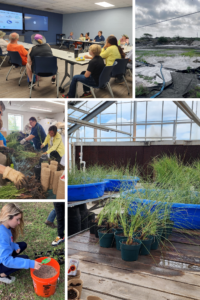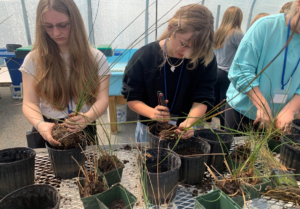Restoring Coastal Habitats in South Texas

The Plan-It Marsh and Plan-It Dunes Projects are habitat restoration initiatives being introduced to the Texas Coast. These initiatives are aimed at strengthening STEM career skills amongst high school youth and at converting degraded coastal habitat along the Gulf Coast into native coastal marsh and dune habitats. With support from our Project Team, Project Partners, volunteers, and our future generation STEM workers, we have an opportunity to restore coastal habitats and create long-lasting coastal habitat demonstration sites that will be shared with our coastal community through education and research opportunities.
Project Overview and History:
 With funding from the Gulf of Mexico Alliance and the United States Environmental Protection Agency, the Plan-It Projects are designed to educate and engage Texans through outreach events and volunteer opportunities, including hands-on plant propagation and habitat restoration activities.
With funding from the Gulf of Mexico Alliance and the United States Environmental Protection Agency, the Plan-It Projects are designed to educate and engage Texans through outreach events and volunteer opportunities, including hands-on plant propagation and habitat restoration activities.
Why is this Important?
Coastal marshes and dunes are vital ecosystems that protect shorelines, support wildlife, and enhance biodiversity. By restoring these habitats, the Plan-It Projects aim to increase public awareness of their importance and provide valuable educational experiences.
Overview of Pilot Project in Texas:
In 2017, Nueces County was devastated by Category 4 Hurricane Harvey, causing widespread destruction of the coastal habitat and community. Just a few years later in 2020, Nueces County experienced extensive coastal flooding and high winds from Hurricane Hanna. Several wetland areas at the Texas A&M AgriLife Mariculture Research Center in Flour Bluff, Texas were severely degraded during these storms. We have an opportunity to restore approximately 2.5 acres of degraded habitat at the Flour Bluff Research Center and create a long-lasting coastal habitat demonstration site that will be shared with our coastal community through education and research opportunities.
Project History:
The Plan-It Projects originated in Mississippi, led by Dr. Hines and her team from the MSU Coastal Research & Extension Center. Since their inception in 2022, the projects have achieved significant milestones in Mississippi:
-
- Partnered with 10 local schools, enhancing STEM skills for 449 high school students.
- Propagated approximately 1,000 native marsh and dune plants.
- Restored 3 acres of degraded coastal habitat.
Educational and Community Engagement:
Partnership with Schools
During the 2024-2025 school year, we are partnering with five high schools in South Texas to provide students with real-world experiences in ecological restoration.
Students will:
- Grow dune or marsh plants at their school. Starter plants, needed supplies, and how-to-lesson provided.
- Strengthen their STEM career skills as they learn about dune and marsh ecology.
- Have the option to design a research project in class to determine optimal plant growth conditions.
- Attend a restoration planting field trip to restore degraded coastal habitat.
Teachers receive:
- A teachers’ workshop.

- 5 Dune Ecology lesson plans.
- 6 Marsh Ecology lesson plans.
- Money to support school costs for restoration field trip, while available.
Volunteer Opportunities
Volunteers, such as Texas Master Naturalists and gardeners, will be instrumental in helping propagate native plants and assist in the restoration process. This is a unique chance to make a tangible impact on the local environment while learning valuable skills.
 Looking Ahead:
Looking Ahead:
As the Plan-It Projects expand into Gulf Coast states, we are excited to involve the community in habitat restoration and educational opportunities. By working together, we can restore these vital ecosystems and inspire the next generation of environmental stewards.
For for more information, contact:
Dr. Stacy Hines
Assistant Professor and Extension Rangeland Habitat Management Specialist
Texas A&M AgriLife Extension Service
stacy.hines@ag.tamu.edu
361-360-4533
Funding Provided By:

Project Team:

Project Partners:

This project has been funded wholly or in part by Gulf of Mexico Alliance and by the United States Environmental Protection Agency under assistance agreement NOA_MX- 02D020220 to Mississippi State University. The contents of this information do not necessarily reflect the views and policies of the Environmental Protection Agency, nor does the EPA endorse trade names or recommend the use of commercial products mentioned in this information.
